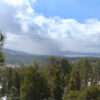 If the unfreezing of credit is paramount to an economic rebound, the first signs of a thaw may be here.
If the unfreezing of credit is paramount to an economic rebound, the first signs of a thaw may be here.
Monday, the Federal Reserve released its quarterly survey of 84 member banks. In it, the Fed says that fewer than half of its responding banks tightened “prime” mortgage guidelines over the last 3 months.
This is good news for active home buyers and other Americans in want of a new mortgage.
“Prime” is a vague term with respect to home loans, but it usually refers to mortgage applicants who can document:
- Equity or downpayment in a home
- Credit scores over 740
- Excessive income versus debt
In looking at the Fed’s survey, we can infer that because less than 50% of banks made credit less available, more than 50% did not. Borrowing may not be easier for prime borrowers, in other words, but it’s not harder, either. Count this as a small victory for the housing market.
All of this said, however, guidelines remain restrictive.
In the 12-month period beginning late-2007, banks continuously clamped down on low credit scores, low downpayments, and high debt-to-income levels. In addition, Fannie Mae added new fees based specific loan traits and second mortgages practically vanished from the marketplace.
The cumulative outcome of these actions precludes many Americans from participating in the current Refi Boom. However, if the trend reported by the Fed continues, lending may open up a bit later this year, providing a boost to housing and to the economy.
Experts believe that the tightening of credit helped create this recession. The loosening of credit, therefore, may be the way out.







First, let me say that I enjoy your blog. You put a lot of work into it and you provide realistic, objective analysis which is rare and refreshing from real estate professionals.
But let me pose a question to you, based in part on your post above:
How exactly is the loosening of credit going to occur? We are in a real estate bubble because banks would give loans to anyone who signed a piece of paper, without regards to income (i.e., no doc/stated income), credit (i.e. subprime, alt-a) or collateral (i.e. 100% LTV, cash-out refis).
Now certainly, not all of those factors are present in every property, but in the aggregate, it allowed people to bid unsustainable prices for real estate that they couldn’t afford, betting only on appreciation and the need to refi perpetually. So long as the banks kept lending, there was always another buyer who would be willing to pay more and the bubble grew. Where did that get us? A real estate bubble of epic proportions, record low affordability and over a trillion dollars in bank losses, much of which has yet to be recorded by our financial institutions.
So, while you say that lending guidelines may not be getting more restrictive, I would argue that it will be a long, long time before they get any less restrictive. I firmly believe that we will be going back to ultra-conservative “prime” lending guidelines for at least a decade as this mess works it’s way through the system. As a result, if a buyer can’t qualify now, their only real remedy is to save, save, save. Lending will not return to the good ol’ days of 100% LTV, stated income, no doc, cash-out lending of the early 2000’s.
I live in the flatlands, which means I saw my house (purchased pre-bubble) nearly triple in price in 6 years and now it is in the process of deflating to a more fundamental value.
It will affect Big Bear as follows — I know of at least two of my neighbors who took out HELOC’s to buy vacation properties in … you guessed it … Big Bear. It is coming time for them to pay the piper and they are desperately trying to unload their Big Bear properties in an attempt to save their primary residences. They are more than happy to sell at a loss, just to get rid of some of the crushing debt. Perhaps they are your clients. I’m curious as to how much of that you are seeing and how much of Big Bear inventory is made up of folks trying to sell a vacation home purchased with HELOC money.
Anyway, thanks for your work with this blog. Did your lot listing on Wilderness in Meadowbrook Estates go into escrow? I don’t see it on the MLS anymore. If so, congrats. That was a nice piece of property.
Thanks for the comment flatlander. I appreciate the feedback and discussion.
As for how loosening of credit will occur, I am not wise enough to know exactly. But, I guess the point of this post is that many lenders did not tighten their standards over the last 3 months. Is it going to be tough for people to get loan right now and in the future? For sure, and it should be given the craziness of the past 4-5 years as you pointed out.
Let’s say it was rainy pretty hard for a while, and it started to flood. Wouldn’t it be a good thing when the rain slows down or even stops? That’s the point I was trying to make. As more and more banks stop tightening their restrictions (the rains slow and the flood goes down), more credit options should be open to buyers.
I am not saying we should go back to the good ol’ days that got us in this mess. Somewhere in the middle sounds good to me. I agree with you and understand why we are here, and I understand why the banks tightened things up. However, I don’t think it will be a decade before things loosen up, especially with credit scores and down payments. We most likely won’t see the same 100% down type loans but buyers will have options.
I got in the business in 1999 and saw the same things you mentioned regarding values in Big Bear. I didn’t know any better.
Prices are already dropping in Big Bear, anywhere from 20-50% for some areas and property types. The lot you mention in Meadowbrook on Wilderness is now priced at $269,900 (has an offer on it). He sold the one next door, same size, for $420,000 a year ago and a similar one sold for $518,000 two years ago. There you go.
I don’t have any stats for the HELOC buyers in Big Bear but I am sure they are out there. I represented a few that bought over the years but I wouldn’t say it was an overwhelming amount. Right now, bank owned properties make up 7% of the total listing inventory and short sales 17%. They make up even more of what is selling right now. I expect that to increase this year.
Thanks again for your comments.